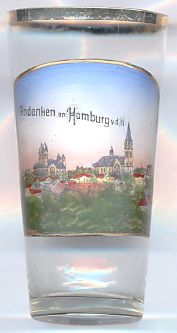

|
| DEUTSCHLAND | GERMANY |
| Bundesland: Hessen | Hesse |
| Regierungsbezirk: Darmstadt | |
| Kreis: Hochtaunuskreis |

 Bad Homburg vor der Höhe (officially Bad Homburg v. d. Höhe') is situated at an elevation of 161 m south of the Taunus mountains in Germany's state of Hesse.
Bad Homburg is the administrative seat of the Hochtaunus district and has a population of about 52,000 (2004).
Bad Homburg vor der Höhe (officially Bad Homburg v. d. Höhe') is situated at an elevation of 161 m south of the Taunus mountains in Germany's state of Hesse.
Bad Homburg is the administrative seat of the Hochtaunus district and has a population of about 52,000 (2004).
The earliest secure written mention is found in a document of the monastery of Eberbach dating from about 1180. Around 1330 the settlement obtained the rights of a market town. The name Homburg is derived from castle Hohenberg, situated on a hill above the town. The suffix vor der Höhe is first documented in 1528 and refers to the location in front of the Taunus mountains (when coming from Frankfurt am Main).
In 1622 Homburg became the residence of the landgraves of Hesse-Homburg (until 1806 as a secundogeniture of Hesse-Darmstadt without sovereignty). From 1648 until 1648 the country was briefly divided into Hesse-Homburg and Hesse-Homburg-Bingenheim. Prince Friedrich II (1680–1708) became famous as "Prince of Homburg". As a general of the Brandenburg troops he attacked, without order, the Swedish army in the Battle of Fehrbellin. The resulting victory established the basis for the rise of the House of Brandenburg-Preußen. These events form the core of Heinrich von Kleist's drama "Prinz Friedrich von Homburg oder die Schlacht bei Fehrbellin" (written 1809/1810, first published in 1821). In 1768 Hesse-Homburg obtained partial sovereignty. Between 1806 and 1814 it was mediatized and was part of Hesse-Darmstadt again. After the Congress of Vienna in 1815 the landgrave of Hesse-Homburg was the only one of the mediatized sovereigns who was able to regain his former country. The small country (85 km²) was even aggrandised by addition of the district Meisenheim (about 176 km²), which before had been part of Pfalz-Zweibrücken. From 1817 until 1866 Hesse-Homburg was a sovereign state in the German Federation. In 1866 the last male member of the Hesse-Homburg died without issue and the country was inherited by Hesse-Darmstadt. After the Austro-Prussian War of 1866 Hesse-Homburg was ceded to Prussia and became part of the Prussian province Nassau.
The spring  Elisabethenbrunnen [left] was found in 1834 and became
the basis of the spa tradition of Homburg.
The
Elisabethenbrunnen [left] was found in 1834 and became
the basis of the spa tradition of Homburg.
The  Kurhaus
Kurhaus
Homburg was connected to Frankfurt in 1860 by a railway line financed by Fraçois Blanc. In 1888 Homburg became well-known throughout the German Emprire as official summer residence of Emperor Wilhelm II. Another frequent guest was King Edward VII of the United Kingdom. The hat that was created for the king by a Homburg hatter became famous as "Homburger".
In 1912 Bad Homburg vor der Höhe became the official name of the town and Bad Homburg became a fashionable place of residence for wealthy inhabitants of Frankfurt. The municipality was extended by incorporation of the neighbouring communities of Kirdorf (1901), Gonzenheim (1937), and Ober-Eschbach, Ober-Erlenbach and Dornholzhausen (1972).
 The protestant
The protestant  Erlöserkirche (Church of Our Lord the Saviour) [left, no. 2331: centre left]
was built in 1901–1905. Already in 1864 Landgrave Ferdinand of Hesse-Homburg had promised to finance the construction of a new church, because
two centuries before, in 1684, the landgraves had torn down the old town church without permission.
However, the landgrave died without heir in 1866 and the landgraviate fell to the grand duchy of Hesse-Darmstadt
which in the same year ceded the territory to Prussia. The Prussian King Wilhelm I now felt compelled to fulfil the promise.
The church was designed in German, French and Italian Romanesque-medieval revival style by Max Spitta, and was completed after Spitta's death in 1901
by Franz Schwechten.
Erlöserkirche (Church of Our Lord the Saviour) [left, no. 2331: centre left]
was built in 1901–1905. Already in 1864 Landgrave Ferdinand of Hesse-Homburg had promised to finance the construction of a new church, because
two centuries before, in 1684, the landgraves had torn down the old town church without permission.
However, the landgrave died without heir in 1866 and the landgraviate fell to the grand duchy of Hesse-Darmstadt
which in the same year ceded the territory to Prussia. The Prussian King Wilhelm I now felt compelled to fulfil the promise.
The church was designed in German, French and Italian Romanesque-medieval revival style by Max Spitta, and was completed after Spitta's death in 1901
by Franz Schwechten.
The catholic  St. Marienkirche (Church of Our Lady) [left, no. 2331: centre right]
was built in 1892–1895. The church in Gothic revival style was designed by the architect Ludwig Becker.
Homburg had become Protestant in 1526 and it took until the 18th century that catholics again resided in the town.
Since 1884 the catholic parish belonged to the diocese of Limburg.
St. Marienkirche (Church of Our Lady) [left, no. 2331: centre right]
was built in 1892–1895. The church in Gothic revival style was designed by the architect Ludwig Becker.
Homburg had become Protestant in 1526 and it took until the 18th century that catholics again resided in the town.
Since 1884 the catholic parish belonged to the diocese of Limburg.
![[scale]](lineal.jpg)